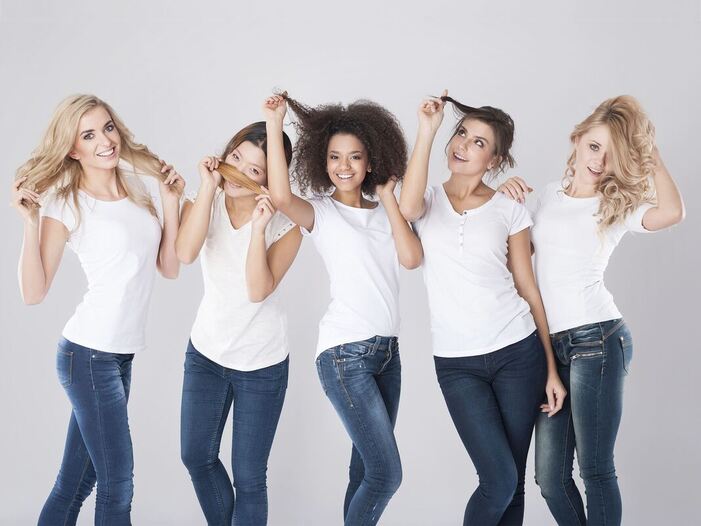 Hair types | Which is yours? Clients are always asking about their hair type, texture and porosity. I found this article on idhair.dk/en/blog/hair-types/ and thought this is great. Let me share it. I will also add what I tell my clients about identifying 1A - 4C hair easier. You really only need to know this for product usage. When I was working with Paul Mitchell they taught us that hair is fabric, ok... Years later another stylist described hair as Silk, Cotton & Wool...🤯(mind blown). It immediately brought me back to JPMS. THEN, taking a color class at Coastline Education, they taught me which type needs protein & which needs moisture...it's all coming together for me. Another class with @keyaartistically came in and blessed us with her knowledge from her educational program @racevstexture, she put it all together for me. So that is how I now describe hair types. Let me explain. SILK: 1A-2A Needs Protein: Fine, soft, silky, prone to frizz, tangles very easily. Very fragile. Can't do as much with chemicals are difficult because the hair is fragile and breaks easily. Understand that you can have 4C hair but it is silky. it's rare but possible. (your silk dress, delicate, Wash n Go. Prone to frizz as well. SILK/COTTON: 2A- 3B, Needs 75% protein/25% moisture: Start to get fullness/body. Mixture silky but has texture, still delicate but more durable, can do chemicals, braids, doesn't break as easily but you still need to be careful. (clothes: maybe you wash it more often, can wear it more, I love sweaters that are cotton & silk). This hair type is beautiful and looks amazing but they need to also be careful. They may be able to color but can not color and relax at the same time. The silk makes it fragile. COTTON: 3A-3C Needs 50%Protein/moisture: Wash n Go. More durable, can do chemicals, switch up colors, soft & more texture. Body for days. This is the hair we are envy of. It falls & looks beautiful all the time. In it's natural state it is prone to frizz & single strand knots will start to form as we move into 4 coils. twist outs and bantu knots look amazing because usually a healthy person with this hair type has lots of hair. Starts to dry out. COTTON/WOOL: 3B - 4C 75%moisture/25% protein: Wash n Go & manipulated into a style.Frizz, tangles easily on the ends, fragile as well. Can't use a lot of heat or chemicals. has to be careful. Starts to dry out because of the wool. Think of a wool sweater. We itch because wool is drying, it is sucking all of the moisture out of your skin. WOOL: 3C-4C and beyond (100% moisture, moisture, moisture). Think of a wool sweater. We itch because wool is drying, it is sucking all of the moisture out of your skin. So we need to make sure we are using moisture shampoos, conditioners, styling products and maintenance products. this type of hair has to formed and usually doesn't do a Wash n Go, must be manipulated into a style. Schedule a one on one if you want to learn how to manage your hair. I hope this article helps you. Fine hair, thick hair, oily hair, curly hair, straight hair... There are many hair types, and maybe you’re not entirely sure which one is yours. Don’t worry, by using these 6 criteria will give you the answer. #1 Density: How much hair do you have? Start by looking at the density of your hair. Density means how many hair strands you’ve got. Don’t worry, you won’t have to count every single one... It’s actually super easy to determine your hair density. How to determine your hair density:Take a large section of your hair and pull it to the side – like you would do if you were making a parting. Your hair density depends on how much of your scalp is visible through the hair. Your hair density changes over time. It may be affected by hormonal changes that may lead to hair loss. #2 Diameter: How thick are your strands? You may have a high hair density and still have thin and fine hair. We use the diameter of each hair strand to determine how thick your hair is. How to determine the diameter of your strands: Grab one strand of hair between your index finger and your thumb and feel it. If you can hardly feel it, you have thin hair. The more you feel the strand between your fingers, the thicker your hair type. Your hair type can be thin, medium or coarse. If your hair is thin and you want to add more volume, you may want to read our article on how to add volume to your hair. #3 Greasy hair: How greasy is your hair? Your scalp produces oil – or sebum. The question is, how much? Once you know if your hair type is greasy, you’ll know how often to wash your hair. How to determine how greasy your hair isWash your hair before bedtime and let it air dry. This prepares your hair for the ‘grease test’. After a good night’s sleep on your newly washed hair, grab a tissue or another kind of thin paper and press it against your scalp in different places – preferably behind your ears or on the crown of your head (the back part of the top of your head). The more grease that’s left on the tissue, the greasier your hair type is. Greasy hair If your hair is of the greasy variety, the greasy blot on the tissue is easy to spot. If your hair is greasy, you’re probably itching to wash your hair daily – and we completely understand. Although washing your hair feels great, those frequent hair washes may actually be the cause of your greasy hair! If you have greasy hair, you might fancy our blog post on how to get rid of that greasy hair. Combination hairThe greasy blot on the tissue is not that visible, but it’s there. It means that you have combination hair, where some sections of your scalp produce more sebum than others. Dry hair If the tissue shows nothing, your hair is of the dry variety. For a very dry scalp, we recommend using a moisturising shampoo like the IdHAIR Solutions No. 2. #4 Hair elasticity – how far does your hair stretch?The elasticity of your hair indicates whether your hair type is strong and healthy. How to determine your hair’s elasticity:Pluck a wet hair strand and stretch it as much as you can. The longer it stretches without breaking, the stronger and healthier it is. When wet, a healthy and strong hair strand actually stretches up to 50% before it breaks. Impressive, right? On the other hand, if your hair strand virtually breaks before you stretch it, you have a low-elasticity hair type. A low-elasticity hair type benefits from a strengthening hair treatment like the one from IdHAIR Elements Xclusive Repair. #5 Porosity: Does your hair float? Take a large cup, fill it with lukewarm water and submerge a few of your hair strands in the water. Wait a few minutes and watch how the hair strands position themselves in the water. This will reveal your hair’s porosity, meaning its ability to absorb moisture. Now, on with the test: Low porosity If your hair strands float to the surface, your hair has few pores, which minimises its capacity to absorb water. Low-porosity hair tends to stay wet for ages after you wash it. For low-porosity hair we recommend the IdHAIR Elements Xclusive Volume shampoo and conditioner. Medium to normal porosity If your hair strands are still floating in the water after a few minutes, your hair is likely to be of medium to normal porosity. It means that your hair absorbs just the right amount of moisture. IdHAIR Elements Xclusive Moisture shampoo and conditioner is the perfect choice for medium to normal porosity hair. High porosity Chemically treated hair strands will most likely sink to the bottom of the cup, because they are porous. It means that your hair strands have lots of pores that absorb a lot of water. If your hair type is highly porous, your hair tends to get frizzy and rough easily. Your hair strand may also be floating vertically in the cup after a few minutes. If you’ve let your highlighted hair grow into an audacious ombre, the porosity of each hair strand may be different at the top and at the bottom: The treated part of the hair strand will sink to the bottom while the root part will reach for the surface. If you have high-porosity hair, you should look for hair care products with lots of nutrients to rebuild the strength of your hair. For example, the IdHAIR Elements Xclusive Repair series, which is designed for damaged hair. The slide test Another way of testing if you have a porous hair type is to perform the ‘slide test’. Grab a hair strand between your index finger and your thumb. Start from the end and slide your fingers up the hair strand. The more ‘bumps’ you feel as you slide along the hair strand, the greater the chance that your hair type is porous. #6. Hair structure – how curly is your hair? Your hair type can also be categorised according to the structure of your hair. There are four main categories: straight, wavy, curly or kinky. These main categories are then further divided into three subcategories. Let’s take a detailed look at each category below. Take a strand of your hair and place it on the table in front of you to determine your hair structure as we move along. Hair type #1: Straight hair Your hair lies flat and straight on the table. If your hair is straight, it typically lies flat from the roots to the tips, and you’ll more often than not have fine hair. Hair type #2: Wavy hairYour hair falls in soft S-shaped waves. You may have a few soft waves or several more defined waves. If you have long hair, your waves will typically form from below your ears and down. Hair type #3: Curly hairCurly hair may be everything from large, soft curls to those spiral-shaped corkscrew curls. Even though you stretch the hair strand flat on the table, it stays curly. Hair type #4: Kinky curlsIf your hair structure is kinky curls, you’ve probably never wondered about your hair structure. Your hair is tightly coiled. Sections of your hair may have different curly structures. For example, you may have a tuft of hair at the back that is curlier than your front hair. Your hair strands may also be porous at the ends and greasy at the roots, meaning that your hair strands require several types of hair care products. Now that you’ve pinpointed your hair type, you’ll find it easier to choose the hair products that will make your hair day. Have a nice hair day! Book an 1on1 to learn how to manage your hair type.
0 Comments
|
AUTHOREurayshia (Ray-Ray) Williams Reed ARCHIVE
March 2024
|



